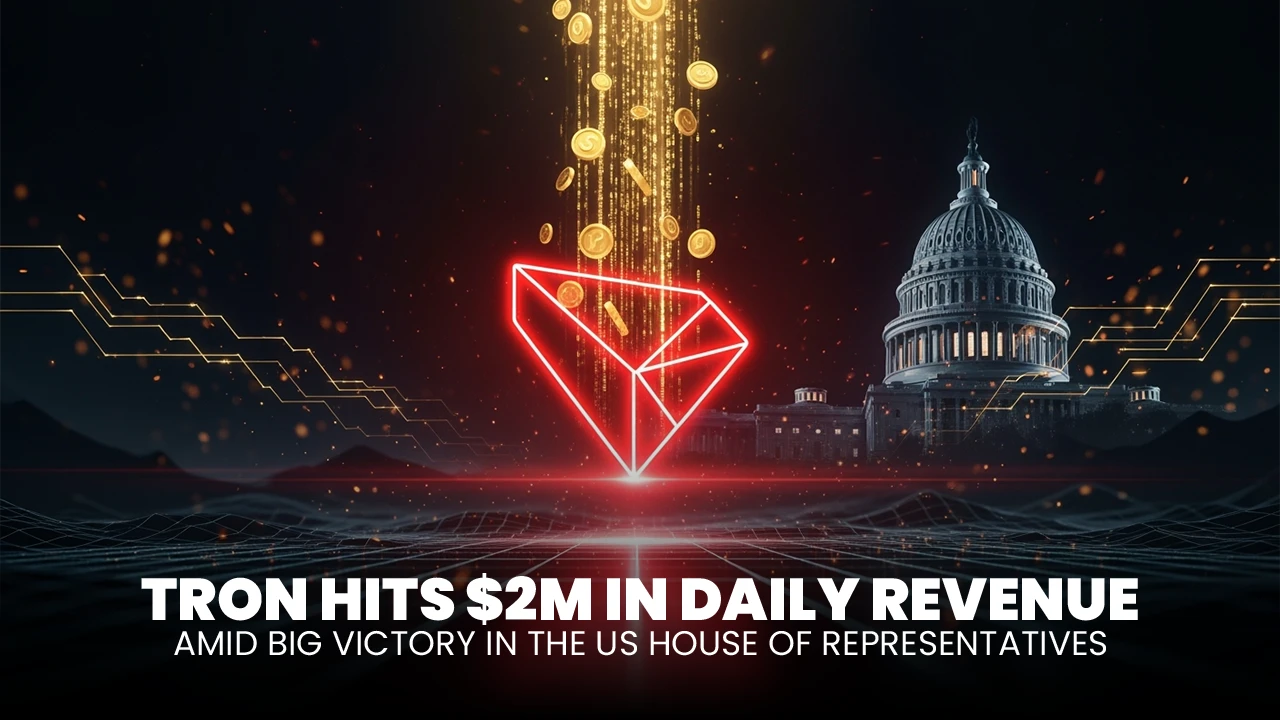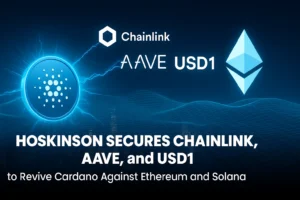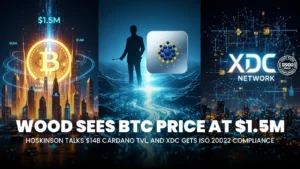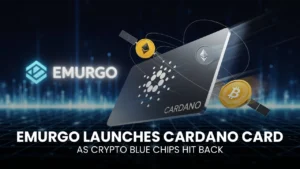TRON Hits $2M in Daily Revenue Amid Big Legislative Victory in the US

TRON (TRX) has emerged as one of the most profitable blockchain networks in the crypto ecosystem, reporting over $2 million in daily revenue. This milestone reinforces the blockchain’s growing relevance in a year already packed with legislative wins for the crypto industry.
- BitTorrent Acquisition Adds Strategic Firepower
- Regulatory Winds Shift in Favor of Blockchain
- DPoS Powers TRON’s Ecosystem Expansion
- Sustained Success Through Technological Leadership
- Conclusion
- Frequently Asked Questions (FAQs)
- 1. How much daily revenue does TRX generate?
- 2. What is DPoS and how does it benefit TRON?
- 3. Why is BitTorrent important to TRX’s ecosystem?
- 4. How is TRX positioned in the current regulatory environment?
- 5. What makes TRX stand out among other blockchains?
- Glossary of Key Terms
The network’s success is largely attributed to its robust architecture, powered by Delegated Proof of Stake (DPoS). This consensus mechanism allows TRON to handle high transaction volumes efficiently, supporting rapid growth and sustained profitability.
According to data from TRONSCAN, the TRON network regularly processes more than 8.6 million transactions daily, with transaction fees surpassing $2 million. The blockchain supports over 240 million user accounts, emphasizing its wide adoption and increasing utility across decentralized applications (dApps), DeFi platforms, and stablecoin transactions.
BitTorrent Acquisition Adds Strategic Firepower
A key element behind TRON’s financial momentum is its acquisition of BitTorrent. Since acquiring the peer-to-peer file sharing platform in 2018, TRON has significantly expanded its ecosystem. BitTorrent now drives an average of 10,000 transactions per second on TRON’s blockchain.
The integration of BitTorrent’s infrastructure has turned TRON into a hub for data sharing and tokenized content distribution. As a result, BitTorrent contributes a significant share of transaction fees, further boosting TRX’s daily revenue.
This synergy between the blockchain’s Delegated Proof of Stake system and BitTorrent’s transactional throughput creates a powerful foundation for continued growth. Unlike traditional blockchains that face scalability issues, TRON’s DPoS consensus protocol enables it to manage increasing demand without compromising speed or cost efficiency.
Regulatory Winds Shift in Favor of Blockchain
TRON’s performance comes at a critical juncture for the blockchain industry. This week, the US House of Representatives passed the GENESIS and STABLE Acts with a vote of 278-129. The legislation provides clearer frameworks for regulating stablecoins and promoting blockchain innovation.
The GENESIS Act, in particular, signals a shift toward greater regulatory certainty, which many in the industry believe could benefit networks like TRON that already maintain high-performance standards. The US Securities and Exchange Commission (SEC) has also called this a “crypto milestone,” as the legislation heads to former President Donald Trump’s desk for final approval.
TRON’s Delegated Proof of Stake system aligns well with this regulatory shift. By enabling energy-efficient operations and faster transaction finality, DPoS positions TRX as a viable platform in a landscape that is beginning to reward sustainable, compliant technologies.
DPoS Powers TRON’s Ecosystem Expansion
Beyond regulatory alignment, TRON’s DPoS protocol plays a direct role in fostering ecosystem growth. Unlike proof-of-work blockchains, which consume high energy, TRON’s Delegated Proof of Stake system enables validators to operate efficiently. This performance advantage encourages more developers to build dApps, NFT platforms, and DeFi protocols on the network.
ALSO READ: ARK Invest Dumps $8.7M in Bitcoin ETFs as BTC Price Eyes $130K Milestone
With the help of its DPoS efficiency, TRX is now the second-largest blockchain for stablecoin settlements after Ethereum. It facilitates over $10 billion in daily stablecoin transactions, including USDT, which remains the most transacted token on the network.
With its scalable infrastructure, TRX is well-positioned to support the influx of institutional and retail users expected to join the crypto industry as the GENESIS Act takes hold.
Sustained Success Through Technological Leadership
The consistent high transaction volume, powered by DPoS, highlights TRON’s ability to scale without friction. As more platforms seek alternatives to congested blockchains, TRON’s Delegated Proof of Stake mechanism offers a compelling case for adoption.
BitTorrent’s continued integration with TRON’s blockchain ensures that the network can handle growing demand across various sectors, including entertainment and financial services. Meanwhile, its capacity to deliver $2 million in daily fee-based revenue proves that profitability and decentralization are not mutually exclusive.
Conclusion
TRON’s combination of strategic acquisitions, high-performing technology, and regulatory alignment sets a new benchmark for blockchain success. The network’s use of Delegated Proof of Stake allows it to maintain industry-leading throughput while staying cost-effective and environmentally responsible.
As crypto regulations continue to transform in favor of transparent and efficient systems, TRX’s model serves as a blueprint for what a sustainable blockchain future could look like.
Frequently Asked Questions (FAQs)
1. How much daily revenue does TRX generate?
TRX currently generates over $2 million per day in transaction fee revenue, driven by high network activity and its integration with BitTorrent.
2. What is DPoS and how does it benefit TRON?
Delegated Proof of Stake (DPoS) is a consensus mechanism that allows TRX to process transactions quickly and efficiently. It supports high throughput, scalability, and lower energy consumption compared to traditional proof-of-work systems.
3. Why is BitTorrent important to TRX’s ecosystem?
BitTorrent enhances TRON’s network by contributing 10,000 transactions per second, making it a key driver of the platform’s transaction volume and revenue growth.
4. How is TRX positioned in the current regulatory environment?
Following the US House’s passage of the GENESIS and STABLE Acts, TRX is well-aligned with upcoming regulations due to its performance, scalability, and use of energy-efficient technologies like DPoS.
5. What makes TRX stand out among other blockchains?
TRX supports over 240 million user accounts and processes 8.6 million+ transactions daily, making it one of the most widely used and scalable blockchains in the world, thanks in large part to its DPoS architecture.
Glossary of Key Terms
TRON (TRX)
A high-throughput blockchain platform focused on decentralizing the internet, known for its support of dApps, smart contracts, and high-speed transactions.
Delegated Proof of Stake (DPoS)
A consensus mechanism where token holders vote for a limited number of delegates to validate transactions and produce blocks. It offers high scalability and low energy consumption compared to Proof of Work (PoW).
BitTorrent
A peer-to-peer file sharing protocol and platform acquired by TRX in 2018. BitTorrent now operates on TRON’s blockchain, contributing significantly to its transaction volume.
TRONSCAN
The official blockchain explorer for the TRON network, offering real-time data on transactions, accounts, blocks, and smart contracts.
Stablecoin
A type of cryptocurrency that is pegged to a stable asset, like the US dollar. TRON supports major stablecoins like USDT, processing over $10 billion in daily transactions.
GENESIS Act
A proposed U.S. law aimed at clarifying regulatory frameworks for digital assets and stablecoins, potentially benefiting blockchain networks like TRX.
STABLE Act
Legislation focused on the oversight and regulation of stablecoin issuance and usage, aligning crypto operations with broader financial compliance standards.
Transaction Throughput
The number of transactions a blockchain can process per second. TRX handles more than 8.6 million transactions daily.
dApp (Decentralized Application)
An application that runs on a decentralized network, such as TRX, without relying on centralized servers.
USDT (Tether)
A widely used stablecoin pegged to the US dollar. It is the most transacted token on the TRON network.




